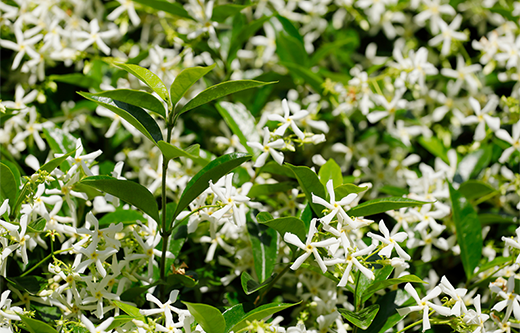
The Jasmine plants may be vines or bushes and some are evergreen. It contains around 200 species native to tropical and warm temperate regions of Eurasia, Africa, and Oceania. The name of the plant ‘Jasmine’ or Jasminum, comes from the Persian word “Yasmin” meaning “Gift from God.” Jasmine is believed to have originated in the Himalayas of western China, a country where this delicate, fragrant flower is known as the “Queen of the Flowers”.
It is mainly the flowers that have been used for time immemorial for their healing and uplifting properties. Jasmine essential oil has been used in many parts of Asia as a natural remedy for depression, anxiety, stress and insomnia for thousands of years.
Jasmine is a source of exotic fragrance in the warmer seasons and an important scent noted in perfumes and has herbal properties. The flower is used to make medicine.
The delicate aromatic tea made from Jasmine flowers became hugely popular in the Ming Dynasty (1368–1644 AD), with the most famous and traditionally scented Jasmine tea coming out of the Fujian region. The tea was drunk not only for its wonderful taste, but also for the many benefits to overall health and wellbeing it imparted.
STAR JASMINE
Star Jasmine (scientific name is Trachelospermum jasminoides) is a species of flowering plant in the family Apocynaceae, native to eastern and southeastern Asia. Common names include Confederate Jasmine, Star Jasmine and Chinese Star Jessamine. Star Jasmine is an evergreen climber mostly used in Traditional Chinese Medicine and other Asian modes of healing. The flowers, stems and leaves of Star Jasmine are the best parts to use.
Star Jasmine is usually used in combination with other plants such as Echinacea and Dandelion as it eases the flow of energy and allows these herbs to work at their best. Star Jasmine flowers are cooked on meals as a remedy for rheumatism.
It is commonly used as a pain killer for treating pains caused by rheumatism, inflammation and spasm. It is also a blood cleaner; it cleans congestion and eases restriction of flow of blood and energy. It is useful for painful sores and rashes, two symptoms of ‘dirty’ blood. It expels the heat of fevers and causes perspiration (which is another sign of its cleaning effects).
Uses
- Arthritis
- Sore throats
- Boils and abscesses
- Respiratory infections
- Can help clear respiratory infections when the perfume of star jasmine is inhaled.
- Traumatic injuries
In China, Star Jasmine is used in folk medicine to treat traumatic injuries.
Star Jasmine is especially useful for the aged:
-
The Star Jasmine leaf is
• restorative and tonic -
The flowering stems are
• analgesic
• antibacterial
• anti-rheumatic
• antispasmodic
• depurative (purifying/cleansing)
• febrifuge (lowering body temperature)
• resolvent (reducing swelling or inflammation)
• tonic (stimulating body functions)
• vasodilator (opening, dilating and relaxing blood vessels) -
Seeds
The seeds are cardiotonic (heart muscle strengthener) and haemostatic (stops bleeding). -
The whole plant
The whole plant is cooked with other foods and used to treat rheumatism.
